Digital advertising on wheels
Advertisers are searching for a better deals at all times and in every country. The ultimate goal: cover all spaces and surfaces with advertising. But not just every type of advertising – nowadays they prefer digital extra-efficient applications. This is the topic we wanted to share with readers in May issue.
It all started with simpler options. Limitations on static advertising in cities lead advertisers to seek new ways and approaches. Here is a simple idea: it costs money to install a static billboard in any city, and afterwards you have to pay taxes. A billboard on a truck needs permission from traffic authorities – but no regular payments to city authorities are necessary. Thus, hundreds of trucks of all models and sizes drive around our cities with printed advertising slogans. Thus, the concept of the mobile billboard was born. There are dozens of names for these: autobillboard, autobanner, autoposter, brandmobile etc.
 |
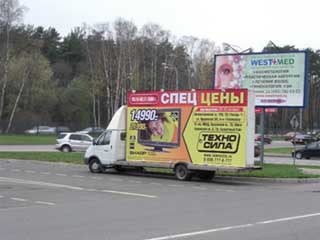 |
| Examples of autoposters | |
Mobile advertising grows exponentially. Why is this market segment so attractive? Minimum expenses. You buy a used truck, mount advertising poster and count your profits! At least that’s how it works in Russia: The Federal Law “On Advertising” regulates stationary advertising while owners of brandmobiles are outside of anybody’s attention. They pay a one-time license fee to traffic authorities, then park their truck on a busy square or intersection.
Outside of Russia the concept of “Billboards on Wheels” turned into a well-known brand. Hundreds of trucks with billboards drive around many countries with the only purpose to be seen by motorists and pedestrians. An average US citizen in 2010 encountered about 1700 advertisements every day. Analysts predict that in 2011 this number will rise to 3000. But advertisers need not only to be seen but to be remembered.
Naturally, even mobile billboard are no longer visible among the multitude of outdoor advertising. Therefore, we make a logical leap to digital – and install LED screens instead of billboards on trucks. Well, such trucks are more expensive, but then digital advertising is so much better and efficient (by now, this is a well-known fact).
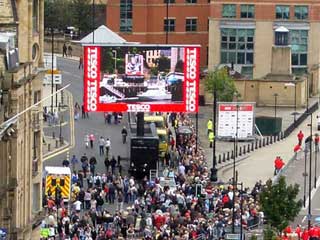 Large mobile trailer-mounted LED 60 sq.m screen
Large mobile trailer-mounted LED 60 sq.m screenPhoto credit: adi.tv
Initially, technological limitations required that LED screens are only very large in size. This required large heavy-duty trailers or trucks with specialized hydraulic lifting systems. The one advantage of having a large trailer along was that owners could house a well-equipped video studio inside. It was only natural that those trailer-mounted screens became a regular feature at short events, shows or concerts. We gladly refer our readers to an excellent article written by Louis Brill back in 2004 “Mobile screens: LED screens on the move”.
As LED technology matured, relatively small screens with tight pitch became better in quality and displayed pictures with TV resolution. Various Chinese manufacturers flooded the Internet with proposals of truck-mounted screens of all shapes and sizes in an attempt to fill this market niche.
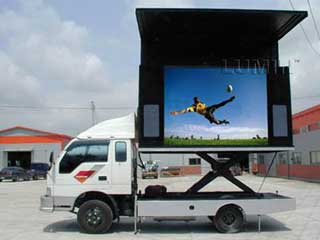 |
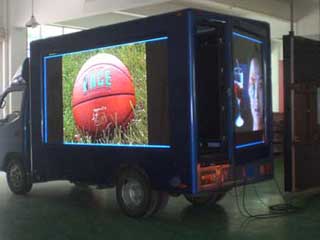 |
| Mobile LED screen with 12 mm pitch. An interesting option for small presentations. Photo credit: Eraled |
Mobile 10 mm LED screen for outdoor advertising Photo credit: Eraled |
Gradually, this lead to a new concept of mobile LED signs which advertising companies started placing primarily on transport. We already wrote about one such company: Titan Outdoor that equipped a fleet of Chicago and New York busses with LED signs for outdoor advertising (see our article “Displays in digital transport advertising”).
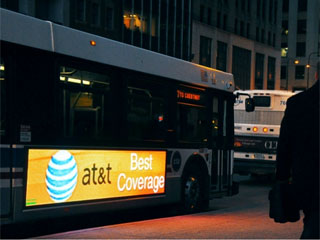 |
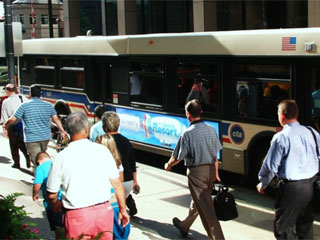 |
| LED signs for outdoor advertising on city busses Photo credit: Titan Outdoor |
|
From public transport LED signs moved on to personal transport. These LED signs with running letters or simplified animation are still rare in our cities; however we have witnessed the “forest fire” effect on the market of LED applications more than once. From the moment some new idea surfaces to the moment it becomes a fad very little time passes. What we see now as a new idea will soon become a trend: some companies started to equip new cars with “autotext” LED line on the back window with a list of standard phrases like “Thank you”, “Happy Holiday” etc.
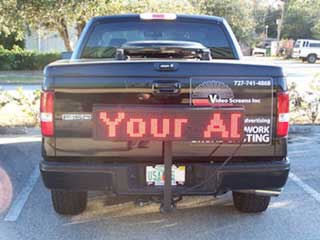 |
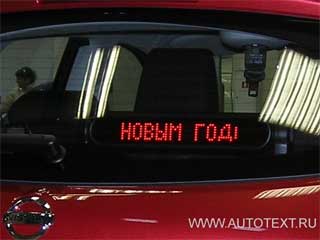 |
| LED panel with running letters function on the back of the pickup truck | LED running line with “autotext” and some simple polite phrases |
The idea to place LED screens on trailers transformed together with the technology. Screens became thinner, lighter – and naturally people no longer needed heavy-duty machinery. Manufacturers offered options of light weight LED screens for private parties and small outings. The trailer carried simple hydraulic lifts and electrical generator.
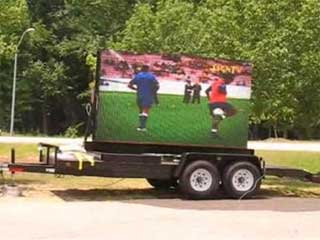 |
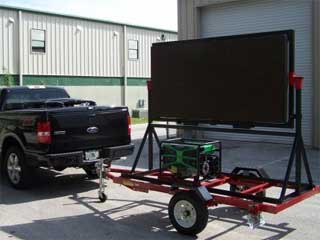 |
| Trailer with high brightness 10 mm LED screen | Simplified version of a trailer with LED panels for small private parties |
Though the number of mobile LED screen options continues to multiply, the topic turned out to be quite difficult, possibly due to legal limitations on dynamic mobile advertising in traffic conditions. Apparently, the number of offers for renting LED mobile screen trucks significantly exceeds existing requirements. Therefore, the market does not grow. Which is a pity!





